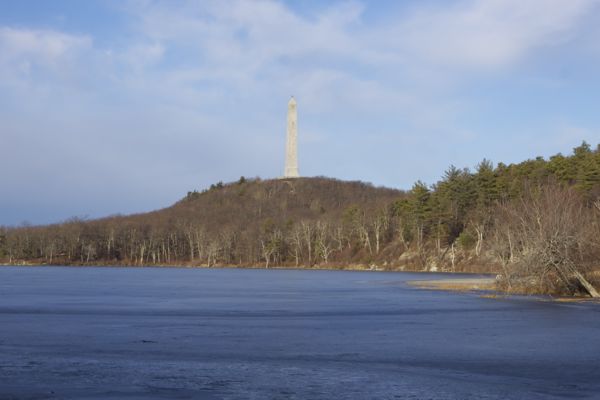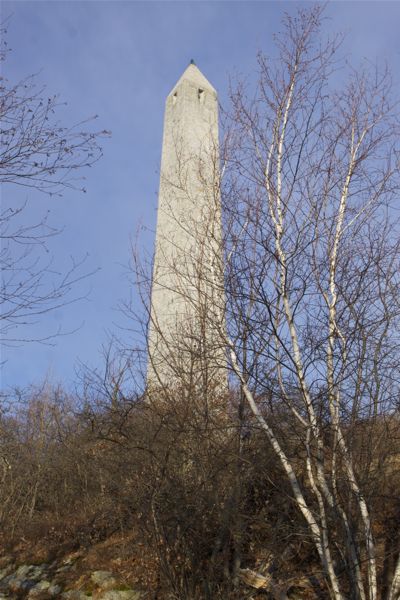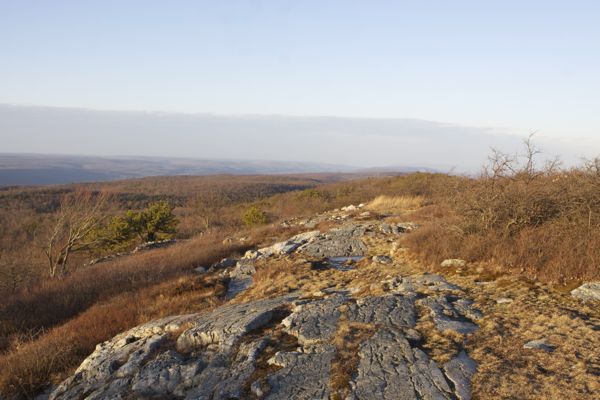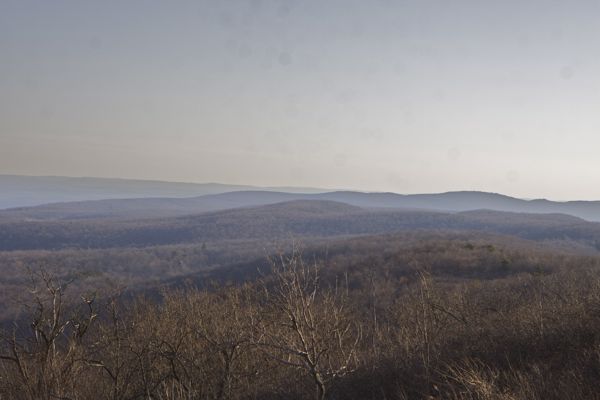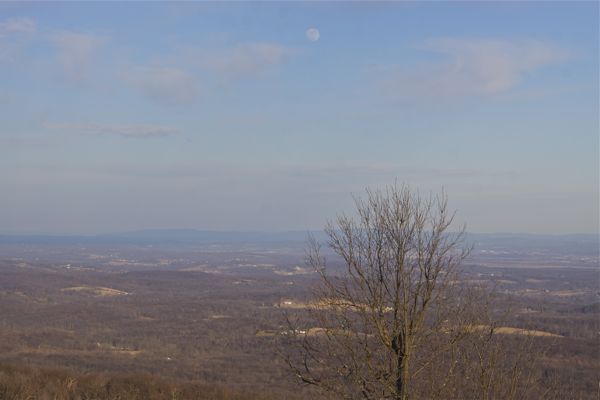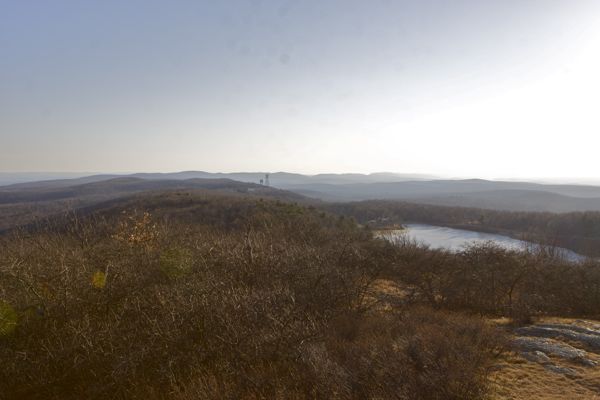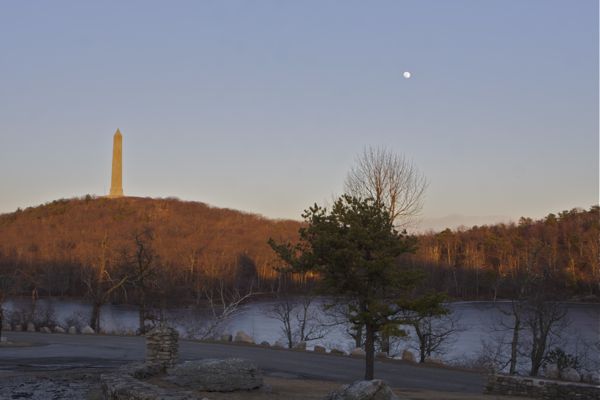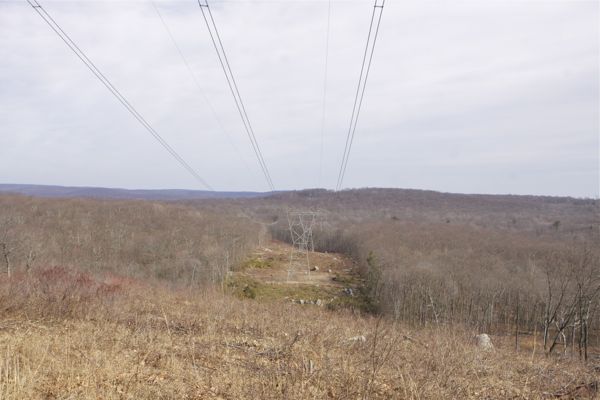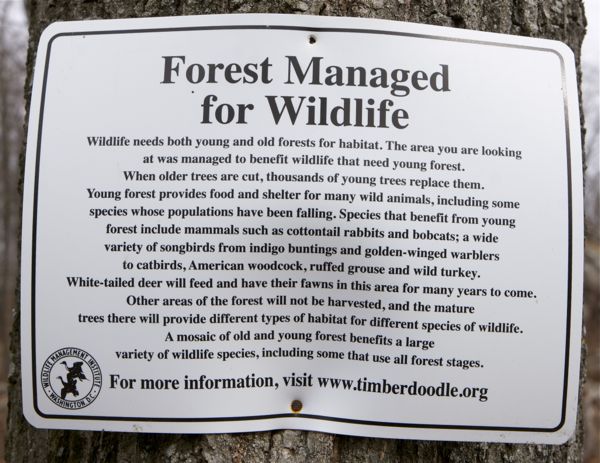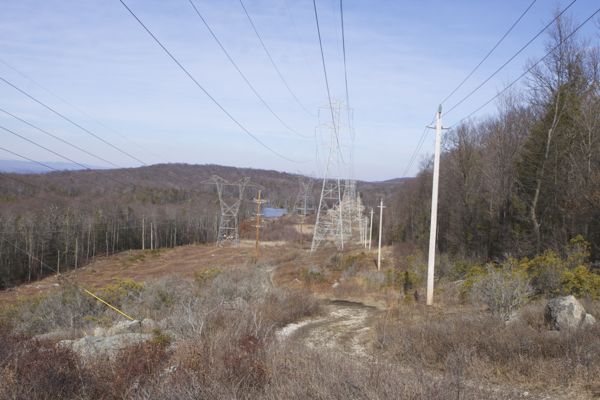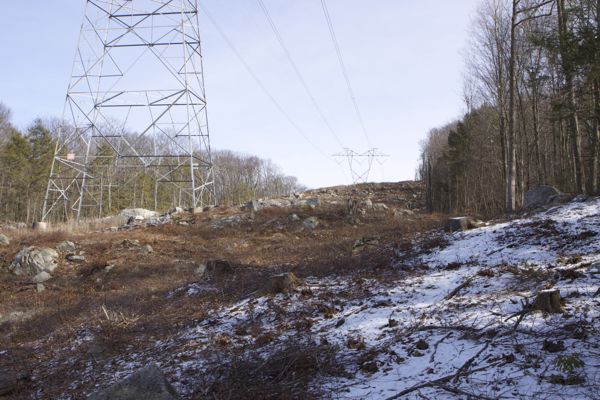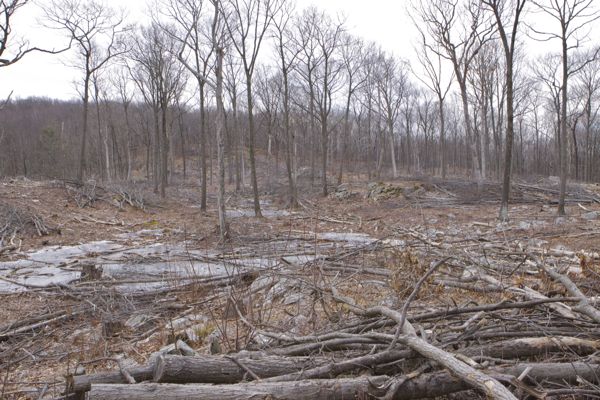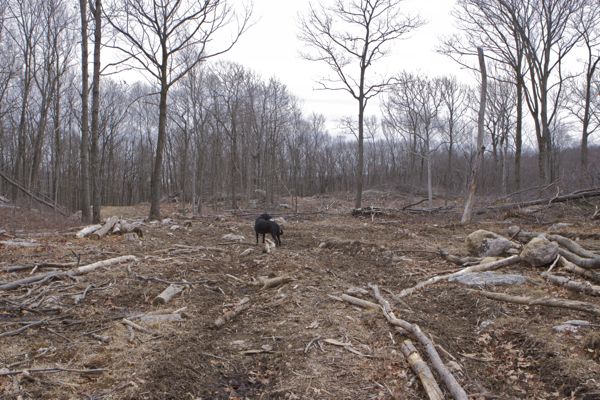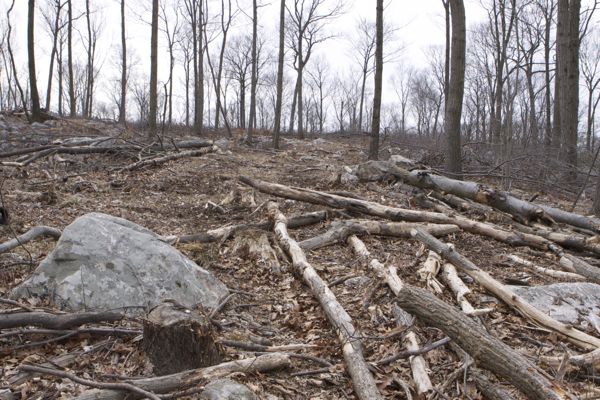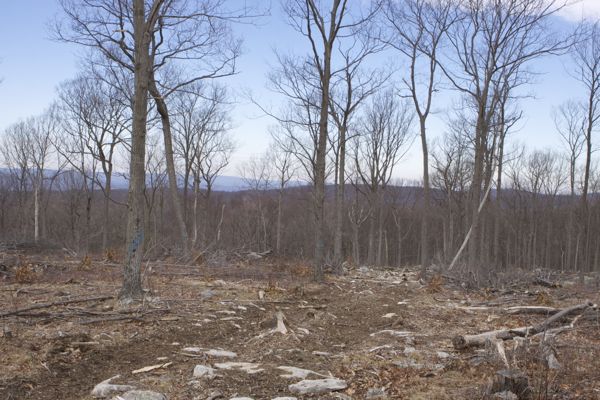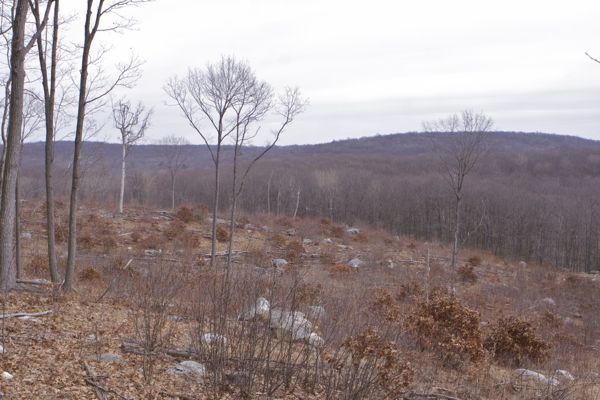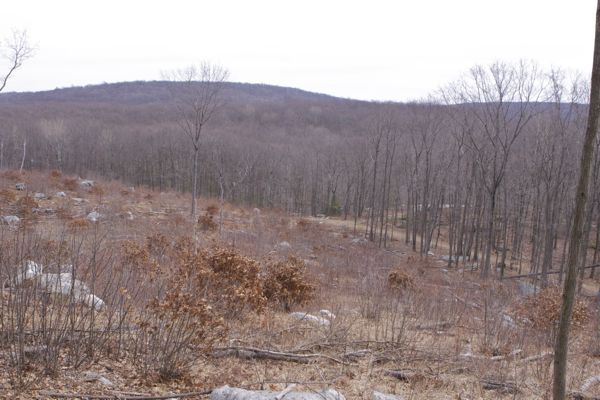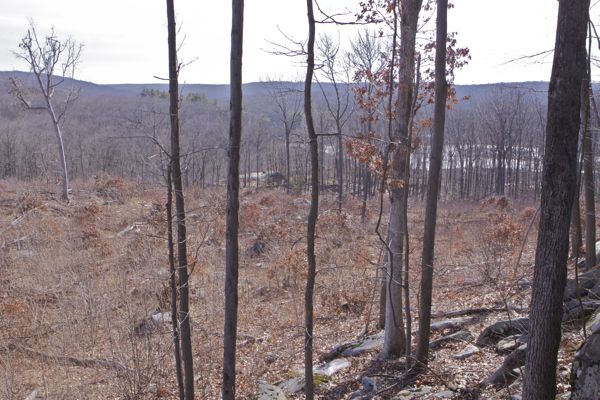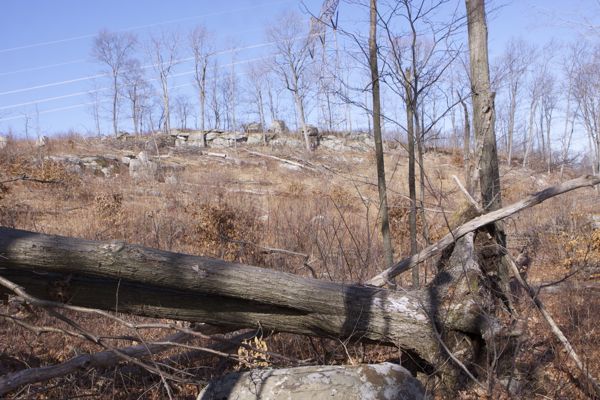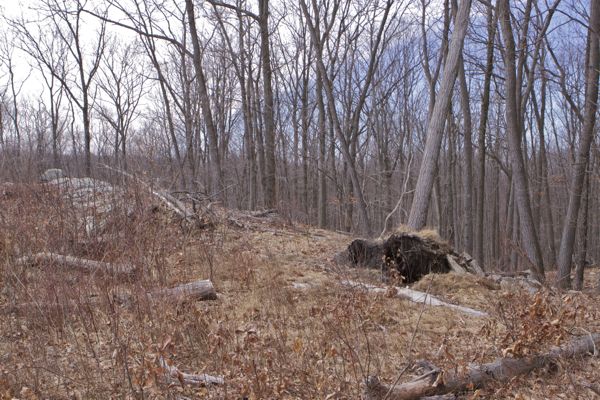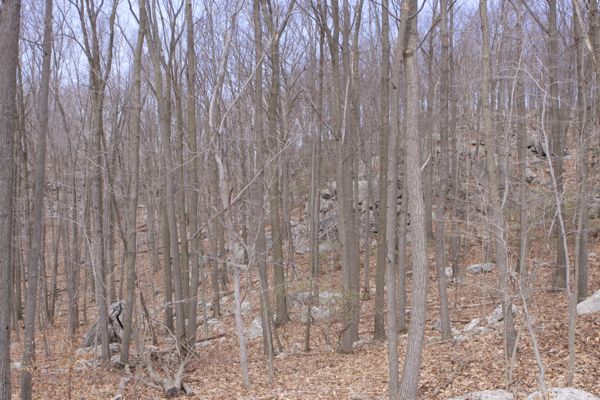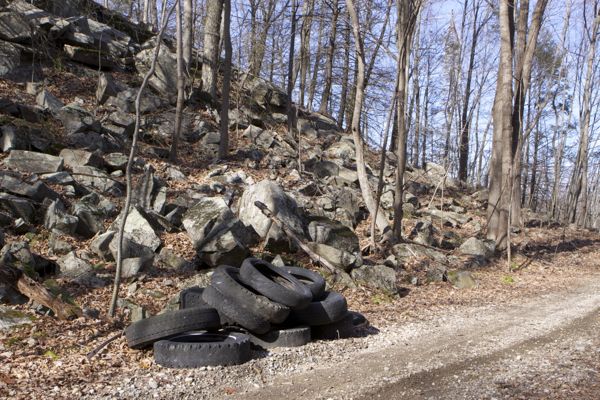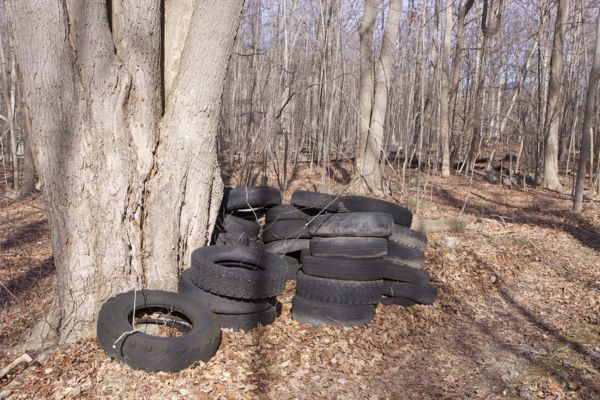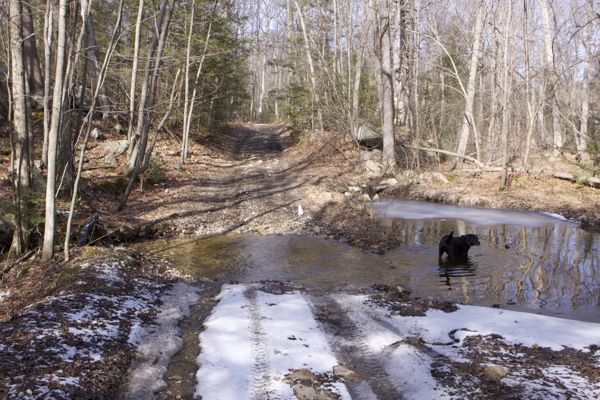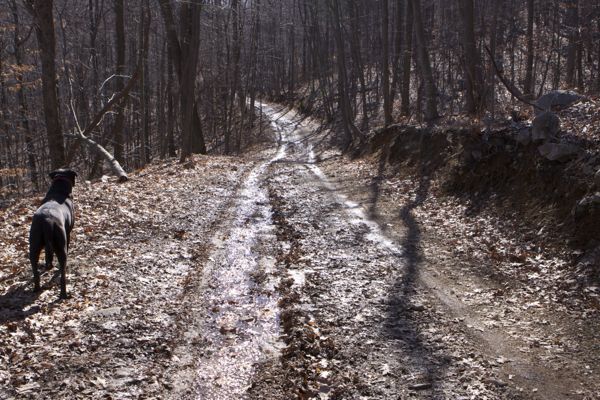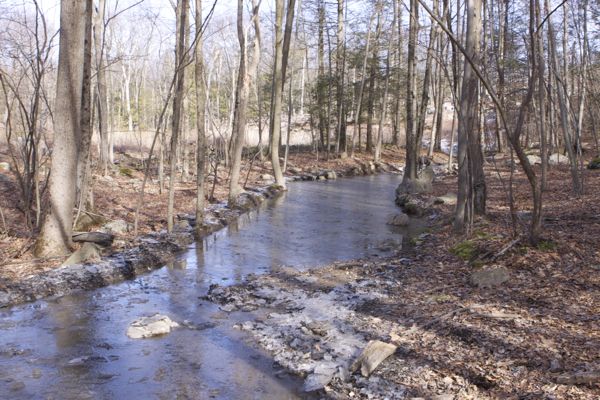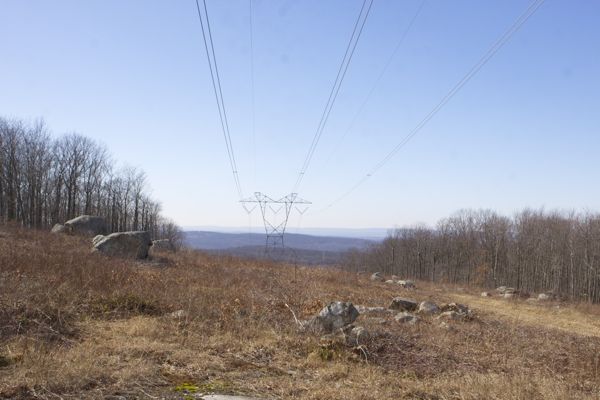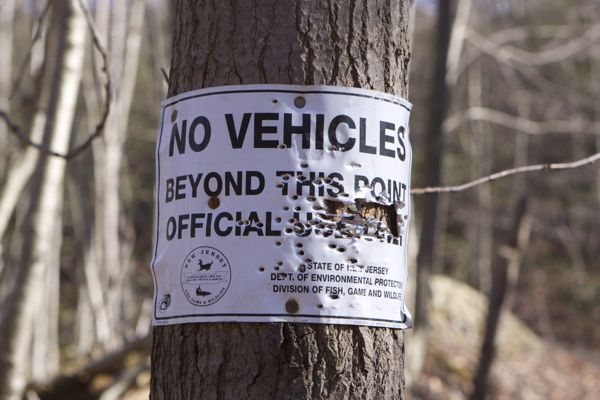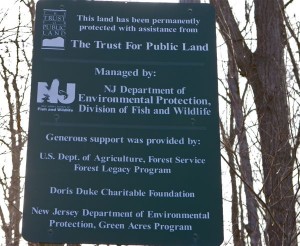Archive
Take A Look At DEP & Audubon “Forest Stewardship” On Sparta Mountain
Conceptions of the Forest Have Consequences
What They Don’t Want You To See
(this is part eight in our series on DEP’s proposed Sparta Mountain WMA logging plan – see parts 1-7 here.)
I was shocked to read that the DEP’s Sparta Mountain “Forest Stewardship Plan” is based on a management strategy to “mimic” (their term) the destruction of utility right-of way and create that destruction in the heart of the interior mature intact forest:
Instead of leaving their [rare plants] existence to the fate of the utility companies, we can manage areas outside of the ROWs near existing source populations to become reservoirs for these plants by mimicking conditions on the ROW. ~~~ DEP Forest Stewardship Plan, p.27
I had to see what this actually looked like on the ground (Google Earth view h/t SD).
After twice taking wrong turns on old logging roads, in my third try, yesterday I finally located the DEP’s prior (Owellian) “seed tree treatments” to create “early successional habitat” and “mimicking conditions” of ROW in the mature intact forest.
Along the way, I passed some interesting scenes, evidence of continuing “non-conformance” with the FSC’s stewardship standards that were “closed” 3 years ago.
Take a look at what I saw – but before you do so, read some of the twisted ideas of DEP foresters and what they recommend about the priority of the public’s normative aesthetic judgments about the management of public lands and how forests should look and feel:
Although wildlife management should be the primary emphasis for any Wildlife Management Area, it is paramount to balance habitat treatments at SMWMA with the recreational needs that users have grown to expect from this property.(p.29)
Sparta Mountain was purchased with Green Acres funds – by what right do DEP foresters think they can elevate wildlife and forestry concerns over preservation? To destroy habitat for some species to promote another? To degrade water quality and recreational experiences to promote one species of bird?
The DEP foresters think the public’s views are misguided and should be manipulated and “redefined”:
Silvicultural treatments may be temporarily unattractive to many. This can be mitigated to some degree through the use of leave- tree buffers around treatment areas known to receive more use, like well-known trails and vistas. Educating the public to the idea that an open park-like understory is less ecologically valuable than dense forest with downed trees and slash, may help to redefine the public’s view of forest aesthetics. This could be accomplished through strategic interpretive station placement.
(does anyone think “an open park-like understory” is what you appreciate and why you hike in the forest?)
Just a little sign oughta fix your problem: (of course this has nothing to do with privatizing the management of public lands; monetizing public natural resources; receiving foundation and government grants and consulting contracts; or generating timber revenue; or funding Audubon, FSC and DEP staff; stimulating the expansion and restoration of a commercial logging industry in NJ. No, none of that. It’s all about the wildlife and the declining golden wing warbler!)
DEP foresters see significant negative implications of public’s preference for preservation or public land – according to DEP, its the misguided “perceptions” of the public that are reducing habitat diversity and harming the economic interests of the forestry industry: (not just a NJ problem)
… social perceptions of forest management in New Jersey has significantly contributed to reduced habitat diversity throughout the region. (p.17)
The public’s attitude towards “preserving” public land became ingrained on passive ownership, and local industries associated with the harvesting and processing of forest products from these properties declined steadily. (p.17)
Here’s how these warped priorities and ideas about forests look on the ground – first, let’s look at the ROW conditions DEP is trying to “mimic” in the interior forest:
Now, let’s look at 2 locations on the top of Sparta Mountain and see if they were successful: this was the first of 2 “seed tree treatments” I found – the photos don’t do the scene justice because they don’t convey the scale of the destruction, communicate how it feels to be in this landscape, or bring out specific details, like the compacted soils, erosion, and wetland pond in the foreground of the first photo:
I continued walking up the logging road, where I could see a vast forest opening on the horizon and felt that there were more “seed tree treatments” to discover – and I was right. This “treatment” was larger – and note the drainage down to the pond & wetlands, the roads, and blowdowns along the edge:
Here is what the current conditions look like- those “even age class” non-diverse forests that must be given the “treatment”: which do you prefer?
Audit OK
Here’s what FSC 2013 Audit found (p.5) :(there were two additional audits in 2014, and 2015 that I have not read yet. The fact that this issue is over 3 years old only makes it worse.)
Evidence of illegal ATV use and dumping was observed at Sparta Mountain Wildlife Management Area (SMWMA) and NJA Hovnanian Sanctuary. At both FMUs use restrictions were not clearly marked at vehicular access points, and no other actions had been taken to curtail the illegal activities. Stakeholders report there is no enforcement at Sparta WMA.
Her is the corrective action Audubon was required to take by 2014:
Organization shall implement corrective actions to demonstrate conformance with the requirement(s) referenced above. Note: Effective corrective actions focus on addressing the specific occurrence described in evidence above, as well as the root cause to eliminate and prevent recurrence of the non-conformance.
Here is the evidence FSC considered to close out (resolve)the issue:
NJA provided correspondence between NJA and New Jersey Department of Environmental Protection (NJDEP) regarding signage and access control, text for new signs prohibiting motorized vehicles, and photographs of one of the signs on the Sparta Mountain Wildlife Management Area (SMWMA) FMU.
The auditor was not able to visit either of the FMUs referenced in this NC; however, evidence of signage and ongoing measures to control unauthorized access was observed during the audit at the Newark Watershed and the NJA Van Gelder Sanctuary.
(note that illegal dumping was not even mentioned).
Here is what I saw both yesterday and on a prior Feb. 10, 2016 hike (these are just 2 of the 7 piles I saw along about 1/2 mile of old logging road now used by PSEG to access the ROW):
Finally, I found violations of FSC water quality standards that was not even identified in the FSC audit. Two streams had been crossed by logging roads – the drainage culverts under the road had collapsed, forcing the stream to flow right through the road and creating a small pond (these are “exceptional value” C1 waters under NJ DEP regulations):
One logging road, that drained the first “treatment” depicted above, had become a flowing stream, eroding soils and delivering sediment to streams and wetlands and a pond:
Roads had been damaged and eroded by ORV’s:
That’s the kind of “Stewardship” DEP foresters and their well funded friends at NJ Audubon are providing. Look again, this is the landscape that are trying to “mimic”:
NJ Highlands Coalition Joins Public Debate On DEP Sparta Mountain Logging Plan
Letter To Towns Blasts Professional Foresters’ Scientific Misrepresentations
“… this statement is patently false …”
(this is part seven in our series on DEP’s proposed Sparta Mountain WMA logging plan – see parts 1-6 here.)
Today the NJ Highlands Coalition wrote a scathingly critical letter to local officials that rebuts claims made by private professional foresters in support of NJ DEP’s proposed Sparta Mountain WMA logging plan.
The primary value of the letter is to provide strong and credible arguments from professional ecologists and academic experts. That should be persuasive in convincing State and local officials that there are many legitimate criticisms of the plan.
The letter is focused on and destroys the arguments of a professional forester, but it also serves as a direct critique of very similar NJ Audubon and DEP’s rationales in support of the logging plan.
While I would have made slightly different and broader policy arguments, used a more critical tone, and explicitly included NJ Audubon and NJ DEP, below I share the full text with readers (emphases in original).
NEW JERSEY HIGHLANDS COALITION
Hon. James Oscovitch
Mayor, Byram Township
February 17, 2016
Re: Sparta Mountain Wildlife Management Area Proposed Forest Stewardship Plan
Dear Mayor Oscovitch,
The New Jersey Highlands Coalition Natural Heritage Committee would like to provide some history and respond to two items from the second bullet point in the February 7 letter from Steven Kallesser, Allegheny Society of American Foresters, to Byram Township officials:
Item 1: “...individual tree selection cutting/harvest. This type of system is currently being successfully implemented by every forested Farmland Assessed landowner in your municipality.”
Response: For over fifty years, farmland-assessed landowners with more than 50% forest acreage have had to submit “Woodland Management Plans” in order to receive tax abatement. The requirements for a Woodland Management Plan are now considered rudimentary, as they give virtually no consideration to ecological issues or sensitive natural resources. Recognizing this, many environmental groups worked hard on New Jersey’s Forest Stewardship Act of 2009, in which Senator Smith at first tried to make Forest Stewardship Plans mandatory on private lands.
Forest Stewardship Plans are intended to be better than Woodland Management Plans, with extra requirements regarding habitat considerations, protection of rare animals, and monitoring of results. However, industry and other private-interest groups objected to making Forest Stewardship Plans mandatory on private land, saying that private landowners should not be “forced” to upgrade their plans, because that would involve additional landowner expenses not required under the 1964 Farmland Assessment Act. Senator Smith had hoped to fund those additional expenses with fund from the Regional Greenhouse Gas Initiative (RGGI), but that money was eliminated by the Christie Administration.
As a result, Senator Smith was forced to make the requirements of the 2009 Bill voluntary. Therefore, landowners can now choose to upgrade their Woodland Management Plan to Forest Stewardship Standards, and even focus on rare animal species, habitat improvements, and invasive species—rather than on producing wood—without losing their tax abatement, but they are not required to do so. To our knowledge, in the 6 years since the Bill was passed, not one landowner has submitted a Forest Stewardship Plan that focuses on rare species, ecological issues, and invasive species removal and also avoids producing wood products, as allowed by the Forest Stewardship Act.
This lack of submissions has occurred because the NJDEP has not written the required regulations for the 2009 Act in six years, so even the few foresters and landowners who do want to avoid producing wood products are afraid that without the regulations, they will lose their tax abatement status. The one Forest Stewardship Plan employed at the southwest end of Sparta WMA on private land consists largely of clear-cuts (called seed tree harvest by foresters), not single tree selection. The goal of the 2009 Forest Stewardship Act—to encourage greater use of Forest Stewardship Plans for improving sensitive natural resources and habitats while focusing less on generation of income from wood products—is not being achieved. There has been little or no recent improvement in the quality of stewardship on private land.
Item 2: “…privately‐owned woodlands are reservoirs of endangered species because forestry practices have created proper structure, light condition, and species composition (page 1, second bulleted point).”
Response: This statement is patently false. The vast majority of healthy populations of rare species, especially plants, occur on public lands in New Jersey. There are indeed rare species on private lands also, but we challenge the author of the letter to provide any instance where a population of a rare species has been shown to increase as a direct result of private lands forestry practices. There is no data and little ecological justification that the standards to which forestry is conducted on private lands have ever significantly benefitted a rare species in New Jersey.
Further, ecologically, there is no such thing as “proper.” Forest structure that maximizes current and future timber production or early successional species is completely different from forest structure that preserves high biological diversity. The NJDEP Natural Heritage Program reports that Sparta Mountain WMA has some of the highest biological diversity and number of plant species with extreme rarity of anywhere yet seen in the NJ Highlands. The proposed Plan for Sparta Mountain WMA is an enormous risk to that diversity and rarity.
Regarding rare species on our public lands as opposed to private lands, the requirements for Forest Stewardship Plans do not come close to protecting the “Natural Heritage of New Jersey that is held in the Public Trust.” For example, Mr. Kallesser also wrote the Forest Stewardship Plan for Weldon Brook WMA, located in Sussex County between Route 15 and Weldon Road, in approximately 2012. That plan designates that logging of one sort or another will eventually occur throughout virtually the entire Weldon Brook WMA. Mr. Kallesser indicated in the Weldon Brook Plan that no rare plants occurred at Weldon WMA. We went there, and found an extremely rare plant species in the first hour (least moonwort, a tiny fern in which the NJ subspecies grows in deep forest along shady stream and spring edges, and cannot tolerate aggressive forestry). We found 2 rare species that day. Upon the urging of the New Jersey Highlands Coalition, the NJDEP Natural Heritage Program sent a qualified botanist to the site and he found around 20 species of rare plants. Concerns regarding rare plant species at both Weldon Brook and Sparta Mountain Wildlife Management Areas are not yet resolved, and this is unacceptable.
The NJDEP has determined that there are over 800 species of rare plants in NJ, including hundreds in the Highlands, but concern for their conservation is being trivialized by many foresters, and others promoting the conversion of maturing forests to “young forests.” Many individuals who have little or no botanical or ecological training repeatedly stated in public that rare plants in NJ do not matter, because many of these plant species are more common far to the south, north, or west of our state. In fact, rarity near the edges of a species’ geographic range is incredibly important from an ecological and evolutionary point of view.
Many rare plants and animals will suffer from implementation of the “Young Forest Initiative.” All rare species must be properly considered before the logging proposed to implement the “Young Forest Initiative” can be carried out without doing irreversible harm to public trust resources.
One cannot compare private land forestry to public land forestry. Public land forestry needs to be held to much higher standards – standards that have yet to be adopted in New Jersey. All of the current standards, even the higher quality U.S. Forest Service (U.S. Department of Agriculture) standards and the Forest Stewardship Council Certification Standards, are basically designed for forest lands that are clearly designated to be “Working Forests,” where it is accepted that the extraction of forest products will be a major driver in the management of those lands.
The thousands of acres of land purchased with Green Acres dollars in New Jersey in the last 50 years were not purchased to prop‐up a logging industry poised to return to New Jersey, nor to implement the “Young Forest Initiative” that is sweeping the eastern U.S. in an attempt to increase early successional species at the expense of deep‐forest species. In the New Jersey Highlands, more deep‐forest species are declining than early successional species, but managing for the imperiled deep‐forest species would not assist in the return of an aggressive timber industry to New Jersey.
The Sparta WMA Plan claims that forestry on public lands will assist the ability of private landowners to implement their logging plans. However, nowhere is this a written or stated objective of the NJ Division of Fish and Wildlife; therefore, it is inexplicable that the authors of the plan have adopted that goal in this plan. Instead, the NJDEP and Division of Fish and Wildlife should be serving as the vigilant stewards of our shared public trust resources, including all rare species, water and wildlife.
Before any more plans for large‐scale logging on public lands are approved and implemented, we must first reach agreement on the big picture. We must settle questions such as: Where will logging be allowed, and where will it be forbidden? What lands shall be “Forever Wild?” What buffers shall be placed around streams, wetlands, reservoirs and other waterbodies? How will the impacts on rare plants that will suffer from high‐intensity sunlight and other microclimate changes be addressed? How will vernal pools and rare natural communities be protected? What are the impacts on scenic and historic resources, and how are they addressed? Are quality recreational experiences protected? Are auditory impacts on both wildlife and humans addressed?
Existing Best Management Practices for forestry are poor at best, and often entirely unsatisfactory or nonexistent, regarding the above-mentioned considerations. Yes, small‐scale endangered-species restoration projects may proceed in advance of the big picture being settled, but we should not be approving any large‐scale forestry plans for large preserved public land holdings, such as this proposal for the Sparta Mountain WMA, until there is broad agreement on an acceptable region‐wide, landscape‐level approach. We need to know what will be forever wild, what will be occasionally managed, and what could be aggressively managed, and for what purposes, before lumping every state conservation holding into the Working Forest and Young Forest Initiatives.
In conclusion, we wish to emphasize that our parklands were conserved at great expense of public dollars and efforts, not to attract a timber industry back to New Jersey. We wish to inform interested stakeholders of an issue involving Hunterdon County parkland in 2010 at the Round Mountain Preserve. A forestry plan was developed there and the trees were marked and ready to be logged without any public input, and the Hunterdon County freeholders had not even informed local municipalities or the County Recreation Commissioners. No rare plants were inventoried or considered in the development of the plan, yet the public found numerous extremely rare plant species in one of the oldest and most undisturbed forest tracts in Hunterdon County. The logging plan was cancelled due to public outcry. The New Jersey Forestry Association responded with the following quote from their President, in a lengthy article in their newsletter, lamenting the fact that the logging at the Hunterdon County Park System’s Round Mountain Preserve was cancelled due to objections by the public:
“A well‐managed forest will go on forever, while a forest left to its own devices will die and become useless to anyone…” Richard M. Conley, President, New Jersey Forestry Association, Spring 2011, Newsletter of the NJFA, No. 120.
In reality, New Jersey’s forests originally grew by themselves, have regenerated by themselves since the peak of deforestation in the mid-19th century—to the point where they now support a diverse suite of forest-dwelling animals and plants—and will continue to grow perfectly well by themselves, especially if we can effectively deal with an overabundant deer population and invasions by alien species, which are the current major threats to maintaining biological diversity.
Thank you for your continued consideration of the Sparta Mountain issue.
Sincerely,
Cinny MacGonagle, Chair, New Jersey Highlands Coalition Natural Heritage Committee; NJ Highlands Coalition Trustee
Dr. Emile De Vito, Ph.D., Manager of Science and Stewardship, New Jersey Conservation Foundation
Dr. Edward Kirby, Ph.D., Professor of Biological Sciences, Rutgers University; NJ Highlands Coalition Trustee
Dr. Sara Webb, Ph.D., Professor of Biology and Environmental Studies, Drew University
Dr. Joseph Zurovchak, Ph.D., Professor of Ecology, Orange County Community College
Dr. Sharon Ann Wander, Ph.D., Wander Ecological Consultants
Wade Wander, M.Sc., Wander Ecological Consultants
Blaine Rothauser, President, BR Environmental, LLC
Dwight Hiscano, NJ Highlands Coalition Trustee
Cc: Joseph Sabatini, Byram Township Manager jsabatini@byramtwp.org
Cheryl White, Byram Township Planning Board Secretary cwhite@byramtwp.org
Margaret McGarrity, Byram Township Environmental Commission mmcgarrity@byramtwp.org Hardyston Township Mayor Leslie Hamilton lhamilton@hardyston.com
Marianne Smith, Hardyston Township Manager msmith@hardyston.com
Anne-Marie Wilhelm, Hardyston Planning Board Secretary amwilhelm@hardyston.com Jefferson Township Mayor Russell Felter rfelter@jeffersontownship.net
James Leach, Jefferson Township Manager jleach@jeffersontownship.net
Stephanie McCormack, Jefferson Planning Board Secretary smccormack@jeffersontownship.net Lori Harvin, Jefferson Township Environmental Commission envirocom@jeffersontownship.net Ogdensburg Borough Mayor Steve Ciasullo ogdensburgnj@gmail.com
Sparta Township Mayor Christine Quinn Christine.Quinn@spartanj.org
Sparta Township Council sparta.council@spartanj.org
William Close, Sparta Township Manager William.Close@Spartanj.org
Maureen Donnelly, Sparta Planning Board Secretary maureen.donnelly@spartanj.org
Janice Stevens, Sparta Environmental Commission Janice.Stevens@spartanj.org
Calling Bullshit On NJ Audubon’s “Forest Stewardship”
Foundation & Government Grant & Consulting Contract Revenue Driven Conservation
Private, closed, insular, & self interested model of management
Absurd & inappropriate for public lands management
(this is part six in our series on DEP’s proposed Sparta Mountain WMA logging plan – see parts 1-5 here.)
[Update #2 – 2/24/16: “Sparta Mountain Backlash”
Former NJDEP Policy Analyst and Planner, and former Policy Director for the Sierra Club’s NJ Chapter, Bill Wolfe, feels that the different groups involved with this plan have other economic motives, rather than real conservation.
“Seeing the players and their games behind the scenes, I find it sinister,” Wolfe said. “They range from the agricultural interests in the farm bureau that look at landowners who own forest blocks of land that want to reap some revenue from that, to other folks that actually want to see a reemergence of the forest products industry in New Jersey — that want to harvest New Jersey hardwood forests in the northern Highlands for timber.“
As far as the Audubon Society’s involvement, Wolfe said that the Audubon is either being selfish in trying to promote the interests of the Golden-winged warbler, or they’re being beyond selfish, into greedy and misleading. According to Wolfe, the Audubon has economic interests as an organization with doing this kind of work. ~~~ end update]
[Update: 2/19/16 – 11:00 pm – I just got an email from a resident who told me that they received direct mail from NJ Audubon to promote this logging plan. I find that reprehensible. More to flow.]
Yesterday, NJ Audubon sent out an “Action Alert” (red font in original) to their members, urging them to support the Sparta Mountain WMA logging plan.
An “Action Alert” from NJ Audubon on a DEP issue is a rare event indeed, about as likely as that left turn Hurricane Sandy took to hit the NJ coast at a right angle.
So, they must be feeling the heat and are desperate.
In contrast with their aggressive and frantic “Action Alert” advocacy, NJ Audubon is aware of many places – including places they’ve designated “Important Bird Area” (IBA) and/or “High Conservation Value Forest” (HCVF) – that are threatened by destruction from pipelines (e.g. PennEast, Baldpate Mountain) yet they remain SILENT, never mind sending out an “Alert” to their members.
NJ Audubon staff feel the need to “Action Alert” their members to support a logging plan, but they don’t say anything when HCVF forest and bird habitat is threatened with destruction by pipelines? Are you kidding me?
NJ Audubon has told the private Forest Stewardship Council (FSC) that they engaged in a Stakeholder process to consult the public about their logging plan – which includes de-designation of Sparta Mountain WMA as “High Conservation Value Forest”.
That is at best, misleading.
I’ve seen the “Stakeholder” list – which amounts to a like minded group of similarly financially self-interested friends – and read the emails and they are extremely misleading (e.g. Audubon requested Stakeholder review of plant inventory data sets and methods as a basis for designation of HCVF, yet used that consultation as evidence of Stakeholder input to de-designate HCVF!).
In politics, these kind of corrupt practices are known as “log-rolling” – pun intended!
The whole process reeks of insider self dealing – there is no transparency, no accountability, and no public involvement.
And I haven’t even gotten to the FSC audit issues yet – that travesty will be a future post. For now, lets just mention that after reading very questionable claims and findings in prior audits, I tried to participate in FSC’s audit (conducted yesterday) of NJA Sparta Mt. project as an official “Observer” and was blocked. If I had not been blocked (NJ Audubon approval is required), I would have been required to sign a confidentiality and non-disclosure agreement and the underlying information that forms the basis of the audit is confidential and under exclusive control of NJ Audubon. I am now about to engage in the FSC dispute resolution process.
This is an absurd, private, and self interested model of management – it is totally inappropriate to bring to public lands management issues.
NJ Audubon designated Sparta Mountain WMA as an “Important Bird & Birding Area” (IBBA).
IBBA designation – alone – should quality Sparta Mountain as HCVF.
Yet now they claim those same conservation values have somehow disappeared – to justify logging the forest.
Let’s be perfectly clear: NJ Audubon is chasing foundation and government grant funding, management contracts, and consulting revenues – they have become dominated by professional foresters, not bird conservationists.
The Sparta Mt. forest plan is based on claims of a single age class forest and lack of forest diversity, which allegedly leads to suboptimal habitat and a decline in ecological health.
But we read from NJ Audubon “Important Bird & Birding Area” (IBA) report on Sparta Mountain the following contradictory assessment (IBA alone should be grounds for “High conservation value forest” designation):
Birds: The different habitats of Sparta Mountain WMA support an exceptional diversity of birds from migrating and breeding hawks and warblers to waterfowl and wading birds. Breeding raptors include state-endangered Northern Goshawks and Red-shouldered Hawks, state-threatened Barred Owls and state-special concern Cooper’s andBroad-winged Hawks. A variety of forest interior and scrub-shrub species also thrive at the Sparta Mountain WMA. Breeding Golden-winged Warblers are especially abundant within the scrub-shrub habitats of right of ways.
Curiously, the link to the NJA field report supporting the IBA designation is not working – that field data is relevant to the NJA decision to de-designate Sparta WMA as HCVF.
The “single age class – lack of habitat diversity” claim by NJA and professional foresters also flat out contradicts “forest mosaic” findings of the USFS Report on the Highlands, which I am so glad Mr. Kallesser (Allegheny foresters) notes here in the Weldon Brook logging plan:
“Most of the forests of New Jersey date back to the turn of the 20th century through the 1920’s. At that point, the chestnut and oak forests were growing back after the heavy and widespread cutting for charcoal. However, an exotic fungus known as the chestnut blight would sweep through the region, eliminating the dominant chestnut overstory, leaving the oak-dominated forest present in much of northern New Jersey today. Other forest age classes were created from later abandonment of agricultural lands, and from forest regeneration harvests, as well as from natural events such as severe wind events, fire, and severe insect infestation. That mosaic of different age classes and cover types supports the high species biodiversity of the region, according to the 2002 USDA Forest Service report on the NJ Highlands.”
That excerpt is by professional forester Steve Kallesser’s firm, for NJ DEP DFW – on Weldon Brook logging. Kallesser is leading the charge on defending the Sparta Mt. plan (more on that set of relationships and financial conflicts to follow).
Further evidence of the flawed data and conservation approach underlying NJA “stewardship” logging plans can be found in the Highland Coalition’s critique and comments on the Mahlor Dickerson plan.
The real NJA motives are made obvious in this excerpt:
Natural resources 2/24/14 – MORRIS COUNTY PARKS COMMISSION
Hearing a presentation and proposal from NJ Audubon (NJA) representatives Jeremy Caggiano, Don Donnelly and John Cecil to establish a management and use agreement to develop a forest stewardship plan for Mahlon Dickerson Reservation and subsequently implement forest management activities on the property after review and approval by the Park Commission. Stewardship needs would be developed using a regional approach that looks at Mahlon Dickerson as part of a large network of open space that includes Sparta Mountain NJDEP Fish & Wildlife, Wildlife Management Area(WMA), the NJA’s Sparta Preserve, Weldon Brook WMA, Hudson Farm(privately owned) and the Berkshire Valley WMA. A management agreement with the NJA would enable the Park Commission to apply for USDA NRCS funding for plan development and implementation through the EQIP Program. Adoption of a stewardship plan could make the MCPC eligible for other grants and cost‐sharing funds for long term habitat and sustainable forest management.
Beware folks, NJA and their professional forestry friends are coming to a forest near you!
Has NJ Audubon pitched to your County or local government or DEP, like they did to Morris County Parks?
Sparta Mountain Update – A Funny Thing Happened On The Way To The Audit
NJ Audubon “De-designates” Sparta Mountain As High Conservation Value Forest
Private deregulation in action
- Approximately 20% of the [Sparta Mountain WMA] forest will be harvested for early successional habitat development by 2022. It is not clear if this rate is consistent with the sustainable harvest calculation. [Note: that’s about 680 acres, folks]~~~ Audit of NJ Audubon, page 13
Brief Update
I’m pleased to report that a lot has happened since we last wrote about the DEP’s proposed logging plan for Sparta Mountain Wildlife Management Area (SMWMA).
In a nutshell: Public and media awareness are growing. A group of expert conservationists have formed to review the DEP’s plan. Grassroots opposition has organized, and local environmental commissions and local governments have raised concerns with DEP.
In response DEP is backpedaling and again extended the public comment period until March 1 and pledged to hold a public hearing.
Professional foresters and NJ Audubon have countered with a propaganda campaign and website to defend their deeply unpopular plan.
I will write in detail about these developments in future posts – for today I want to focus on NJ Audubon’s recent and perhaps their most outrageous move that has angered leading NJ conservationists and, in my view, seriously undermines their credibility and integrity.
NJ Audubon de-designates Sparta Mountain as “High Conservation Value Forest”
NJ Audubon is certified and manages commercial logging on over 12,800 acres of forests in NJ under the private “Forest Stewardship Council” (FSC) program (see: FSC US Forest Management Standard (v1.0) – Forest Stewardship …).
The overwhelming majority of this forested land – 91% – is located in two publicly owned forests in the Newark Watershed and on Sparta Mountain WMA, which are Audubon’s two largest FSC “Forest Management Units” (FMU’s) (see Appendix VII).
Under FSC standards, NJ Audubon designated both the Newark watershed lands and Sparta Mountain FMU’s as “High Conservation Value Forests” (HVCF) due to exceptional biodiversity (SMWMA) – (not certain of basis for Newark Watershed HCVF designation). HCVF’s are subject to strict management standards that tend to promote preservation and limit the intensity of commercial logging in order to protect those high conservation values. FSC management options for HCVF include preservation and “no cut”.
Intent: High Conservation Value Forests are managed to protect and maintain their identified high conservation value attributes. In some cases, active management is consistent with these attributes, and in other cases (e.g., most old growth forests), active management is specifically precluded.
According to FSC standards, mapping HCVF should be based on a “precautionary approach”, particularly under uncertainty or lack of data, including issues like suitable habitat and presence or absence of species:
2.6.2 | Using the precautionary approach
The Precautionary Approach means that when there is a threat of severe or irreversible damage to the environment or a threat to human welfare, responsible parties need to take explicit and effective measures to prevent the damage and risks, even when the scientific information is incomplete or inconclusive, and when the vulnerability and sensitivity of values are uncertain14. In the context of HCV identification, this means that when there are reasonable indications that an HCV is present, the assessor should assume that it is present.
But, in contradiction of any “precautionary approach”, shockingly, in an FSC audit (2013) of NJ Audubon’s compliance with FSC standards, on page 4 we learn that:
NJA modified its High Conservation Value Forest (HCVF) assessment by removing most of the Sparta Mountain Wildlife Management Area from HCVF status. The prior classification was based on landscape habitat suitability models and not on actual presence/absence data species and ecosystems that would contribute to HCVF classification. This decision was based on stakeholder input and field surveys by NJA confirming that the species predicted by the models did not occur or if present they were not likely to be there in sufficient numbers to indicate HCVF status. See Appendix I.
Got that? But why would NJ Audubon want to do that?
Because it looks really bad for a self described bird conservation group to support commercial logging of HCV forests with significant habitat and/or populations of rare, threatened or endangered species of plants, amphibians, reptiles and birds?
Because it might make the foresters uncomfortable and limit logging?
It is a form of private deregulation. The fox guarding and designing the hen house AND writing the standards for hen house construction!
What’s happening here is like allowing a developer to designate a stream and determine the width of the regulated buffer, or to delineate a wetland and determine the wetland’s classification and transition area and mitigation requirements – all by himself with no DEP or public oversight. If the standards were too restrictive, the builder could simply modify them, e.g. “de-designate” a stream designation if the buffer widths were too big or reclassify the wetland if the transition area or mitigation requirements were too costly. And then, after designating the resource value and setting the standards to protect that resource value, to hire the inspector (auditor) to determine compliance with the standards set by the builder! And all with no public process or local or sate government oversight or approvals.
I contacted FSC’s auditor (Rainforest Alliance, contact info below) to question Audubon’s de-designation by arguing that it conflicts with FSC’s “precautionary policy”, FSC HCVF criteria, and existing field studies that contradict the basis and rationale offered by NJ Audubon in support of the de-designation.
But, I am not an expert and lack the credentials to back that up. But I can rely on experts in USFS who also noted conservation values on Sparta Mountain and he Highlands region, including:
The Highlands serve as a major migratory flyway for many neotropical bird species, many of which populations are in decline. Of particular concern to ornithologists are the 70 to 75 species of interior nesting neotropical migrants such as the red-eyed vireo, American redstart, Kentucky warbler, and eastern pewee. These species require large undisturbed forest patches. NJ/NJ Highlands Regional Study (US Forest Service, 2002)
So, here is the reaction of a prominent expert PhD conservation biologist who is familiar with SMWMA:
Sometime before April 2012, in its Forest Stewardship Council certification process, New Jersey Audubon modified its High Conservation Value 1 (HCV1) assessment for the lands in its collective “Forest Stewardship” planning assemblage, by removing most (perhaps all ?) of the Sparta Mountain Wildlife Management Area from “HCV1″ status.
Their prior classification of Sparta Mountain WMA as “HCV1″ was based on landscape habitat suitability models and NJ Heritage database reports, not on actual presence/absence data of species and ecosystems that would contribute to a “HCV1″ classification. The removal of the “HCV1″ classification for Sparta Mountain was based on stakeholder input and field surveys by NJ Audubon, whereby they assert that various species predicted by the landscape models and NJ Heritage database did not occur there, or if present they were not likely to be there in sufficient numbers to indicate “HCV1″ status. (See Appendix I.4, starting on the bottom of page 19 of the Rainforest Alliance Audit of the NJA Forest Stewardship Council Certification. The date on this document is 2012. http://fsc.force.com/servlet/servlet.FileDownload?file=00P4000000DX5LzEAL )
Since then, NJDEP Natural Heritage has documented numerous rare plants throughout Sparta Mountain; we also know of bird surveys and reptile surveys from previous periods that have found numerous rare animals. Besides the old (including NJ Audubon bird surveys) and new data spanning over 20 years, the collective conservation community has known for decades that Sparta Mountain contains a regionally and nationally significant concentration of biodiversity values (the definition of “HCV1″).
It is absolutely unacceptable that Sparta Mountain WMA is not-considered HCV1 in NJ Audubon’s Forest Stewardship Council certification. This audit document is difficult to tease apart to look for additional items of interest/concern, since one has to be familiar with all the jargon. But this deviation from what we all know to be obvious, that Sparta Mountain has high regional biodiversity significance, is a real shock. Many thanks to Bill Wolfe who found this FSC Audit Document and noticed that Sparta WMA had been downgraded. There may be other items in the audit document that we may want to bring up with Rainforest Alliance.
I let Jamie Overton of the Rainforest Alliance aware of this concern at about 4PM today. Her contact info is below, in case any of you would also like to contact her, which I strongly encourage. It also turns out the Rainforest Alliance field person will be at Sparta Mountain tomorrow (Wednesday) to inspect/determine if the logging and other activities that have taken place so far conform to standards (I expect that on-the-ground work probably conforms just fine). Of course, a field visit on a cold February day will reveal nothing about the biodiversity value classification of Sparta Mountain WMA.
Auditor’s contact info:
Jamie L. Overton
Forest Certification Coordinator & CW POC, US Region
Rainforest Alliance, 65 Millet Street, Suite 201
Richmond, Vt 05477
Phone: (802)-923-3765
Fax: (802)434-3116
joverton@ra.org
(*Update: there were several errors in this post regarding the dates of the audits – the most recent is 2015, not 2013 -and the start of logging in 2011 that I have corrected. I must now review the most recent audit and may have to further update this post in light of more recent information. I plan on a separate future post on other audit related issues as well.).
[End note – here are additional FSC HCVF designation criteria the could be applied to Sparta Mountain – people hold let NJ Audubon, RFA, FSC and DEP know how they feel about them:
Intact forests >1000 ac (valuable to interior forest species)
Examples:
- The best examples are in public and/or private conservation ownership such as the Big Reed Preserve in Maine, parts of the White Mountain National Forest in New Hampshire and Maine, and parts of the Adirondack and Catskill Parks in New York
- There are areas of a few thousand acres in northern Maine where species composition and structure closely approach natural conditions due to light harvest history and a relatively long time (30-50 years) since the last harvest. In the Northeast, rare communities or assemblages of communities dominated by a rare community that approach or exceed 500 acres (200 ha) in area are normally delineated and managed as rare ecosystems under HCVF
Critical situations – watershed protection: A forest that is part of a local drinking water catchment or irrigation supply system, or is a critical source for a remote location (i.e., water is pumped to a remote location) may be considered a ‘critical situation’, particularly when people are dependent on the guarantee of water for drinking or irrigation, or where the regulation of water flow guarantees the existence of fishing grounds or agricultural land on which the local people are dependent, protects downstream communities from flooding, or provides critical protection to rare, threatened, or endangered aquatic species.
Large landscape-level forests: Relatively contiguous areas of forest (which may be crossed by land management roads or public roads). At the minimum these forests are likely to be thousands or tens of thousands of acres in size. However, “large” is relative to ecoregion landscape context (particularly the size of forested blocks in the ecoregion) and might be smaller or larger than this figure as indicated by consultation with regional experts. In ecoregions where natural forests are heavily fragmented by forest type conversion or land use conversion, the increased value of smaller occurrences of remaining natural forest should also be included in the assessment. The forest may be in single or multiple ownerships.
